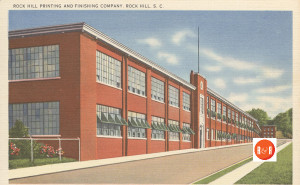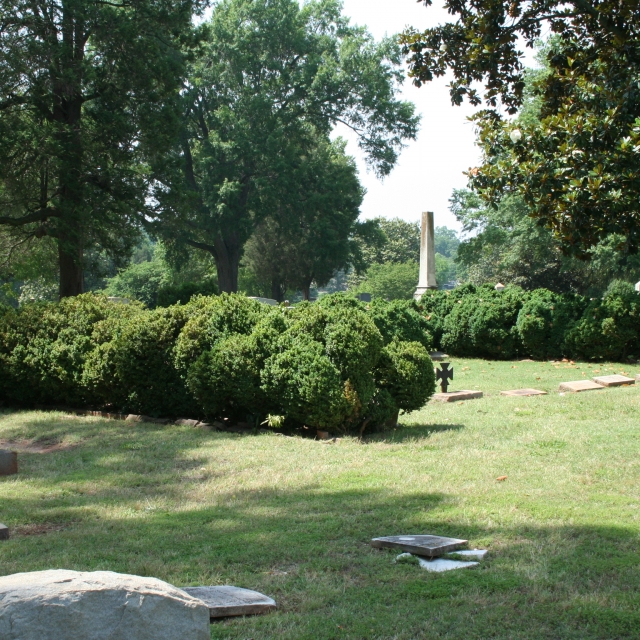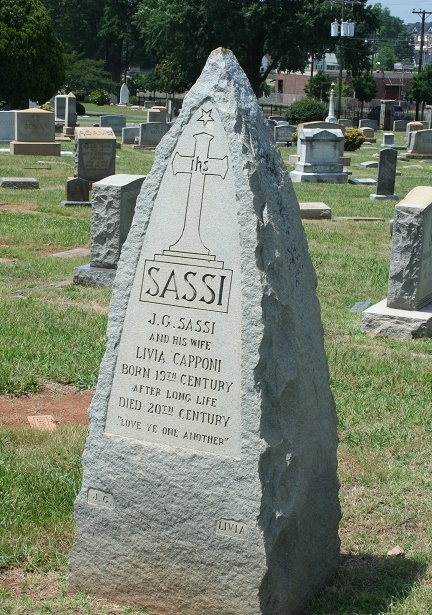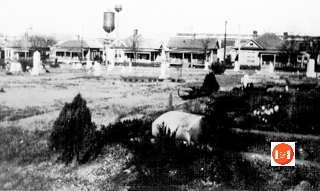The Yorkville Enquirer reported on Jan. 9, 1873 – “A sale of land was recorded from Ann H. White to the Intendent and Wardens of Rock Hill for a lot of six acres of land for a city cemetery, $150.”
The Rock Hill Herald reported on Oct. 14, 1886 – “Mr. A.D. Holler has contracted with the town council to put a new fence around Laurelwood Cemetery.”
The Yorkville Enquirer reported on Dec. 18, 1888 – “Mr. J.C. Sharpe, Marshall of Rock Hill has wonderfully improved the appearance of the cemetery, having cleared off the vacant lots and the walks.”
The cemetery’s importance to Rock Hill’s heritage can not be overstated. Therefore, prior to beginning the tour, take a few minutes to read Laurelwood’s National Register nomination prepared by, Paul M. Gettys, for the S.C. Dept. of Archives and History. The nomination provides a detailed history which is unsurpassed.
The cemetery tour was created to assist individuals learn about the cemetery itself, the decorative elements found on tombstones, artisans who created the stones, as well as data on individuals buried here. These people were community builders of the town on many levels; early development, landowners, merchandising, banking, and more. Use the map to guide you through the cemetery. While doing so, be cognizant of the fragile nature of the tombstones and vegetation throughout the cemetery. Do not lean or rest on tombstones nor cut flowers or vegetation!
LAURELWOOD CEMETERY, ROCK HILL In 1919 the London Printery of Rock Hill printed a pamphlet on Rock Hill’s Laurelwood Cemetery which included a history as well as rules and regulations regarding burials, placement and size of stones, etc. Since no church had a cemetery connected with it Laurelwood was the only cemetery in town other than several graveyards for blacks. The following is an excerpt of the history. “The present Laurelwood, consisting of 20 1/2 acres, more or less, was acquired by the City in three separate purchases. The original tract, consisting of six acres, more or less, was acquired by the City December the 13th, 1872, from Anne White and others under the administration of Capt. Iredell Jones as Mayor. The second tract, consisting of six acres, more or less, was purchased July 13th, 1894, from A. H. White, Executor under the administration of J. W. Fewell as Mayor. The third tract, consisting of 8 1/2 acres, more or less, was purchased April the 6th, 1914, from J. H. Witherspoon, under the administration of C. W. F. Spencer as Mayor. As time as passed the first and second tracts have been sold out to lot owners in their entirety. In the sale of these lots no provision was made for the permanent care of the solds sold; each individual owner taking care of his lot in his own manner, and while some of these lots have been and are kept up to a high state of beauty, others have been neglected due to various reasons. Whole families having passed out, or relatives moved away, leaving uncared for sections scattered over the area, which as a whole detracts from the general beauty of the Cemetery. “In the first and second tracts the City has furnished a general care of the walks and property unsold to lot owners, and a reasonable care of the lots, as to removing weeds, etc., and as a whole of the Cemetery expenses have been greater than the revenue due to the sale of lots. . . . “In developing and opening up the third section, referred to hereafter as the J. H. Witherspoon Tract, and described as follows: ‘All that tract of land in the City of Rock Hill, S. C., having the following courses and distances: Beginning at a stake on the South side of White street, Laurelwood Cemetery Corner, running thence with said Cemetery Line. . .to stake on W. N. Ashe’s corner. . .to stake on White Street . . .thence with White Street to the beginning, containing eight and one-half acres, more or less, bounded by White Street, by Laurelwood Cemetery and by the lands of J. B. Steele, J. B. Johnson, W. N. Ashe and others as will more fully appear from a plat of the same made by W. W. Miller, Surveyor, April, 1914.” Courtesy of the YCGHS, June 1991
A Glimpse at Laurelwood Cemetery – by P.M. Gettys
Rock Hill was created in 1851 as a depot on the new Charlotte and South Carolina Railroad Company line. In its early years, it grew by attracting rail business from surrounding rural areas such as Ebenezerville, and gradually a number of stores and houses were built. Most of the early residents migrated to the village from the surrounding countryside. Upon their deaths, they were generally buried in the church grave yards or family burial plots of their ancestors. After the Civil War, Rock Hill began to grow more rapidly, and it attracted new residents from a much wider area. The churches which were established in the growing village were placed on city lots, with no room for cemeteries. It became evident that a municipal cemetery was needed to serve the rapidly growing community. The development of Laurelwood was one of the early civil projects of the town.
The original section of the cemetery was a six-acre tract which was purchased by the city from Mrs. Ann Hutchison White on December 13, 1872. The family of George and Ann White, were instrumental in the early development of Rock Hill. Married in 1838, they acquired land which today includes a large part of central and northern Rock Hill. Their home, known locally as the White House, still stands on East White Street. George died in 1848 during the early development of the rail line which would create the town. Ann White continued to

The Bleachery Building was across the street from Laurelwood Cemetery. Courtesy of the Allen Postcard Collection – R&R
manage the farm and oversaw the sale of many parcels which led to the development of commercial, residential, and cultural elements of the new community. The site of Laurelwood was on the western edge of the White family property.
The original six-acre section of Laurelwood was laid out on a high point of ground by Rev. James Spratt White, son of George and Ann White, and Iredell Jones, who was serving as Mayor of Rock Hill at the time. It is believed that White created the name. Their plan included curving drives and family burial plots. The first grave was that of Edgar McCosh, the 14-year old son of Captain and Mrs. Reid McCosh, who lived on Black Street in a brick home which still stands. The McCosh family was typical of many of the new residents of the city. Captain McCosh, a Civil War veteran, brought his family to Rock Hill from Chester County to take a position as a clerk in one of the new mercantile establishments. The original plots were sold quickly, and in 1894, a second six-acre section was purchased from the estate of Ann White. (The Rock Hill Herald reported on Oct. 17, 1896 – Mr. W. W. Miller began his survey of Laurelwood Cemetery Wednesday.) By 1914, lots in the first two sections were sold out, although many individual grave sites remained unused. A third tract of 8.5 acres was purchased in that year from A. H. Witherspoon, a son-in-law of Mrs. White. In the original sections of the cemetery, individual families had been responsible from the care and maintenance of their plots. The city accepted maintenance of the drives and walks. This arrangement was proving difficult, as some families were neglecting the maintenance of their plots, detracting from the beauty and appearance of the whole. The city undertook a study of modern cemetery management, and it was decided to implement a policy of perpetual care by the city of the new lots in the Witherspoon tract. This policy was later extended to the entire cemetery.
The Rock Hill Herald reported on Sept. 6, 1883 – “There are reports that some of the tombstones in Laurelwood Cemetery have been desecrated.”
The original two sections of the cemetery were shown in a drawing done in 1912 by W. Walter Miller, who was a partner in the Miller and White civil engineering firm in Rock Hill and who also served as City Engineer. To lay out the new Witherspoon Tract in a professional manner, the city employed Earl S. Draper, a Landscape Architect and City planner from Charlotte, N. C. Draper, who was trained at the University of Massachusetts, won a position with John Nolen of Boston, a pioneer in city planning and the founding president of the American Planning Association. Draper was sent to Charlotte in 1915 to oversee the development of the Myers Park area, a large suburban development. By 1917, Draper had formed his own firm in Charlotte and it quickly grew to become one of the largest landscape architecture and planning firms in the nation, with branch offices in Atlanta, Washington, and New York. Draper’s work included parks, cemeteries, private estates, college campuses, upper class residential areas, and mill villages. In Rock Hill, he designed the expansion of Laurelwood Cemetery and also a portion of the campus of Winthrop University.
The Yorkville Enquirer reported on July 11, 1894 – “The RH City Council will enlarge the cemetery and have purchased four acres from Major A.H. White. He also donated another acre and the cemetery now includes twelve acres.”
The YV Enquirer reported on May 3, 1895 – “Some graves in the cemetery have been exhumed and relocated. This work being made necessary by the widening of Laurel Street. Mr. Devinney, the keeper of the cemetery, is doing this work.”
The Herald reported on April 29, 1896 – “Mr. J. E. Worley, of the Herald office, is connected with one of the largest marble finishing works in the South. He has the latest and most beautiful designs in monuments.”
The Herald reported on Nov. 25, 1896 – “James A. McFadden has been to Yorkville to help create a camp of the Woodman of the World. The Rock Hill camp has over ninety members.” (Many monuments in Laurlwood Cemetery were erected by the Woodmen of the World.)
The Herald reported on Nov. 28, 1896 – “That a new driveway was laid off at Laurlwood Cemetery on Monday. The new grounds added to the cemetery are being laid off in regular plots. We hear there is some talk of building a keepers house near the center of the grounds.
The Herald reported on Sept. 8, 1897 – “That Laurelwood Cemetery is in good condition. The keeper is J.M. Devinney. He uses female convicts to weed out the cemetery.”
The Herald on Dec. 10, 1902 – “The United Daughters of the Confederacy are scheduled on Jan. 19th, Lee’s Birthday, to deliver the Crosses of Honor.” (The program had started in 1899 and this may have been the first time the UDC in Rock Hill participated in the program.)
The Herald reported on Feb. 21, 1903 – “Capt. W.H. Edwards, who is associated with the firm of L.D. Childs and Co., of Chester, has just completed the erection of a handsome monument over the grave of Ms. Kathleen Moore in Laurelwood Cemetery in Rock Hill.”
The Herald reported on June 11, 1940 – “The City Council will borrow $11,500., to purchase property from W.N. Ashe adjoining Laurelwood Cemetery.”
———————————————
Laurelwood’s cemetery tour was created to assist individuals learn about the cemetery itself, the decorative elements found on tombstones, artisans who created the stones, as well as data on dozens of interesting individuals. Be cognizant of the fragile nature of the tombstones and vegetation throughout the cemetery. Do not lean on tombstones!
Cemeteries in Rock Hill, S.C. are easily searched at Cemetery Finder. Users may also enjoy the Rock Hill Downtown Walking Tour. Brochures for this tour are available at the Main Street Kiosk as well at the historic White Home in downtown Rock Hill.
TOURS BEGINS BY CLICKING ON THE INDIVIDUAL’S NAME
R.A. Springs / Susan J. Springs
Stay Connected
Explore history, houses, and stories across S.C. Your membership provides you with updates on regional topics, information on historic research, preservation, and monthly feature articles. But remember R&R wants to hear from you and assist in preserving your own family genealogy and memorabilia.
Visit the Southern Queries – Forum to receive assistance in answering questions, discuss genealogy, and enjoy exploring preservation topics with other members. Also listed are several history and genealogical researchers for hire.
User comments welcome — post at the bottom of this page.
User comments always welcome - please post at the bottom of this page.








Share Your Comments & Feedback: